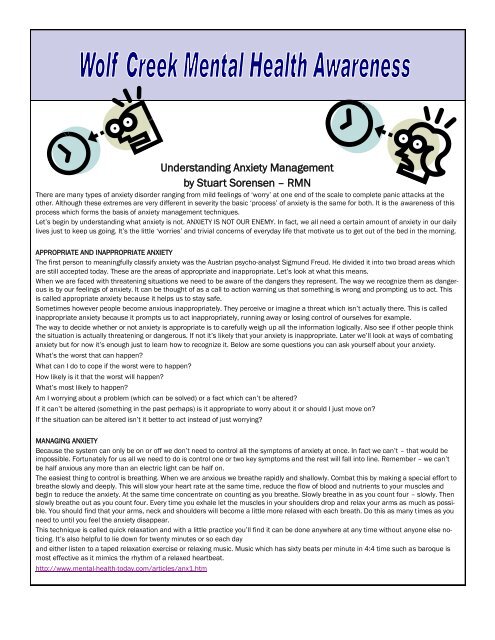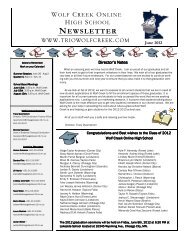Term 2 (end) Newsletter - Wolf Creek Online High School
Term 2 (end) Newsletter - Wolf Creek Online High School
Term 2 (end) Newsletter - Wolf Creek Online High School
You also want an ePaper? Increase the reach of your titles
YUMPU automatically turns print PDFs into web optimized ePapers that Google loves.
Understanding Anxiety Management<br />
by Stuart Sorensen – RMN<br />
There are many types of anxiety disorder ranging from mild feelings of ‘worry’ at one <strong>end</strong> of the scale to complete panic attacks at the<br />
other. Although these extremes are very different in severity the basic ‘process’ of anxiety is the same for both. It is the awareness of this<br />
process which forms the basis of anxiety management techniques.<br />
Let’s begin by understanding what anxiety is not. ANXIETY IS NOT OUR ENEMY. In fact, we all need a certain amount of anxiety in our daily<br />
lives just to keep us going. It’s the little ‘worries’ and trivial concerns of everyday life that motivate us to get out of the bed in the morning.<br />
APPROPRIATE AND INAPPROPRIATE ANXIETY<br />
The first person to meaningfully classify anxiety was the Austrian psycho-analyst Sigmund Freud. He divided it into two broad areas which<br />
are still accepted today. These are the areas of appropriate and inappropriate. Let’s look at what this means.<br />
When we are faced with threatening situations we need to be aware of the dangers they represent. The way we recognize them as dangerous<br />
is by our feelings of anxiety. It can be thought of as a call to action warning us that something is wrong and prompting us to act. This<br />
is called appropriate anxiety because it helps us to stay safe.<br />
Sometimes however people become anxious inappropriately. They perceive or imagine a threat which isn’t actually there. This is called<br />
inappropriate anxiety because it prompts us to act inappropriately, running away or losing control of ourselves for example.<br />
The way to decide whether or not anxiety is appropriate is to carefully weigh up all the information logically. Also see if other people think<br />
the situation is actually threatening or dangerous. If not it’s likely that your anxiety is inappropriate. Later we’ll look at ways of combating<br />
anxiety but for now it’s enough just to learn how to recognize it. Below are some questions you can ask yourself about your anxiety.<br />
What’s the worst that can happen?<br />
What can I do to cope if the worst were to happen?<br />
How likely is it that the worst will happen?<br />
What’s most likely to happen?<br />
Am I worrying about a problem (which can be solved) or a fact which can’t be altered?<br />
If it can’t be altered (something in the past perhaps) is it appropriate to worry about it or should I just move on?<br />
If the situation can be altered isn’t it better to act instead of just worrying?<br />
MANAGING ANXIETY<br />
Because the system can only be on or off we don’t need to control all the symptoms of anxiety at once. In fact we can’t – that would be<br />
impossible. Fortunately for us all we need to do is control one or two key symptoms and the rest will fall into line. Remember – we can’t<br />
be half anxious any more than an electric light can be half on.<br />
The easiest thing to control is breathing. When we are anxious we breathe rapidly and shallowly. Combat this by making a special effort to<br />
breathe slowly and deeply. This will slow your heart rate at the same time, reduce the flow of blood and nutrients to your muscles and<br />
begin to reduce the anxiety. At the same time concentrate on counting as you breathe. Slowly breathe in as you count four – slowly. Then<br />
slowly breathe out as you count four. Every time you exhale let the muscles in your shoulders drop and relax your arms as much as possible.<br />
You should find that your arms, neck and shoulders will become a little more relaxed with each breath. Do this as many times as you<br />
need to until you feel the anxiety disappear.<br />
This technique is called quick relaxation and with a little practice you’ll find it can be done anywhere at any time without anyone else noticing.<br />
It’s also helpful to lie down for twenty minutes or so each day<br />
and either listen to a taped relaxation exercise or relaxing music. Music which has sixty beats per minute in 4:4 time such as baroque is<br />
most effective as it mimics the rhythm of a relaxed heartbeat.<br />
http://www.mental-health-today.com/articles/anx1.htm



